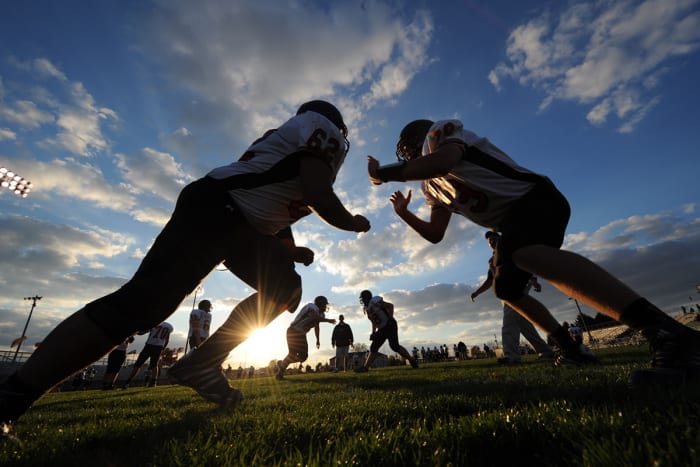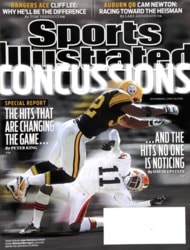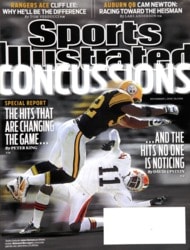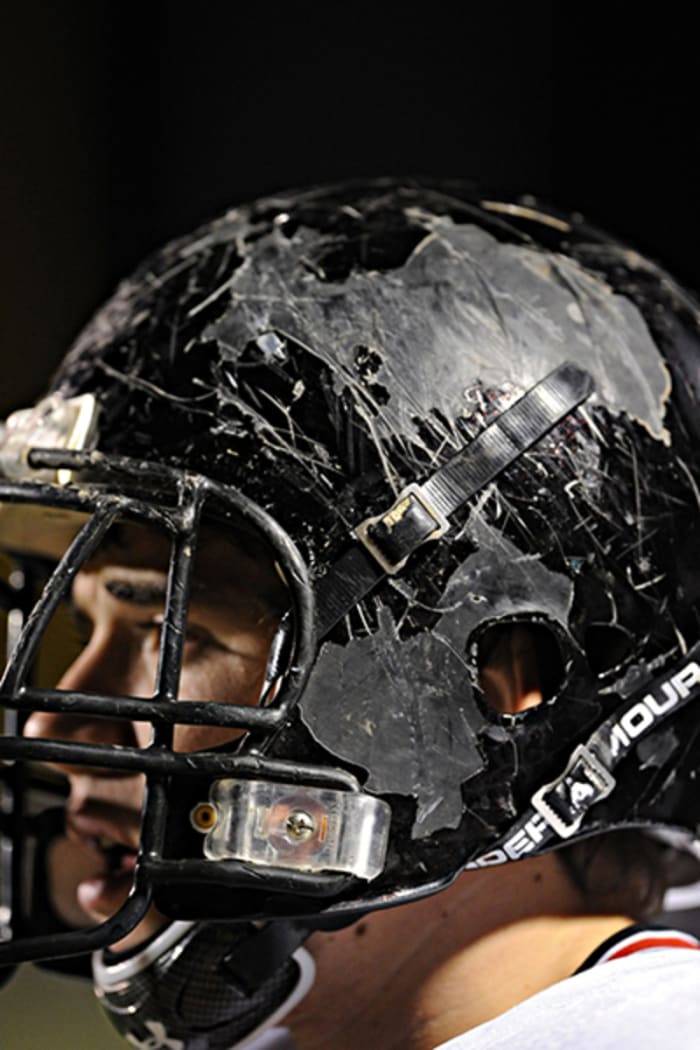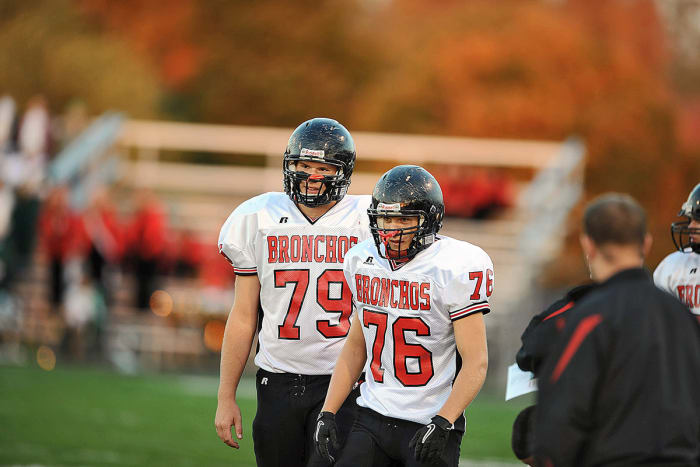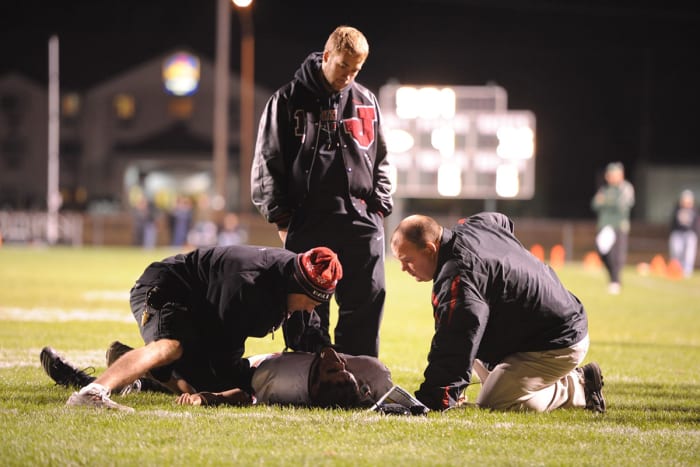The Damage Done
You wouldn't guess that Jefferson High football players Joel Ripke and Brandon Stumph are part of a scientific breakthrough. Purdue researchers who put sensors in the helmets of the seniors from Lafayette, Ind., certainly didn't. Ripke, a mountainous 17-year-old at 6'6" and 260 pounds, is the Bronchos' starting right tackle. His buddy Stumph, a starter at defensive end, is a more mundane 6'1" and 190 pounds, but with a thirst for contact. His black helmet looks like one of those chipped and gouged bowling balls that hasn't beaten a straight path in years.
Despite their easy camaraderie and Penn-and-Teller size difference, Ripke and Stumph line up across from each other in practice and get after it, with Stumph breaking out every duck, dodge, chop or bull rush he knows to get past Ripke's forklift arms and Frisbee-sized mitts. "If I'm not bigger than the dude, I like to hit him with my helmet," Stumph says, "and then use a move so I can get his hands off me." Nor does Ripke shy away from putting hat on hat. He's been taught that effective run blocking requires three points of contact on the defender: hand, hand, helmet.
Despite their frequent bell-ringings and clock-cleanings, neither Ripke nor Stumph has suffered a concussion in practice or in a game. That would be unequivocally gratifying news, except that the Purdue researchers' data, to be published in the Journal of Neurotrauma, tell a far more troubling story. The findings suggest that while the NFL is going to unprecedented lengths to control the violent collisions that produce concussions, brain trauma in football may start much earlier, and much less conspicuously, with hits that never raise an eyebrow, much less a penalty flag.
Before the 2009 football season the group of Purdue engineering professors, athletic trainers and graduate students fitted 23 of the Bronchos' helmets with accelerometers and gave players both the ImPACT test—a computerized neurocognitive exam that tests memory and concentration—and tests of working memory while their brains were monitored with magnetic resonance imaging (MRI). The idea was to establish a baseline for each player against which he could be reexamined after a concussion. Says Thomas Talavage, a Purdue associate professor of biomedical engineering and electrical and computer engineering, "We were looking to understand what kinds of hits cause a concussion and what the consequences are."
Using NFL-sponsored studies as a guide, the researchers figured that hits in excess of 80 times the force of gravity (heading a soccer ball produces around 20 Gs) would cause concussions. So the Purdue researchers were stunned when, on the first day of full-contact practice, they started seeing hits of 100 Gs or more. "I thought, Oh, my god, we're going to be carrying these kids off the field," says Eric Nauman, associate professor of mechanical and biomedical engineering.
It turned out, however, that no particular magnitude of hit correlated with a concussion. One player holding the line on an extra-point attempt took 289 Gs to the helmet from a converging pair of would-be kick blockers. "You could hear the hit in the subdivision next door," says Evan Breedlove, a biomedical engineering grad student and member of the study team. But the lineman was fine. In fact, three weeks into the season the Purdue team had just one concussion for its study. (There were concussions among Bronchos players who were not part of the test.) So the researchers had players from the study who had never suffered concussions retake the ImPACT test and get their brains scanned with functional MRIs (fMRI), which image cerebral blood flow to pinpoint active areas in the brain. The players were meant to serve as a control group for later comparison to concussed teammates. But the first lineman who came in as an ostensible control subject surprised the researchers when, compared with the preseason, he scored 20% lower on the visual memory section of the ImPACT test, which requires rapid identification of recurring patterns. The player had no trouble with the verbal section, though, and Talavage began to think there might be something wrong with the test itself, which is used by the NFL and many college and high school teams to gauge whether a player has recovered from a concussion.
A few concussions did arise as the season went on, but the researchers continued to bring in nonconcussed players for ImPACT tests and fMRIs. And then they saw it again: Another kid who had never suffered a concussion flubbed the visual memory section of the ImPACT test. Of 11 players who took midseason testing, three had suffered concussions during the season and eight had never had concussions. Of those eight, four nevertheless showed significant declines in visual memory. In fact, the players with the most impaired visual memory skills were not coming from the concussed group but from a group that in the week preceding the test had taken a large numbers of hits—around 150—mostly in the 40 to 80 G range.
If the test scores were accurate, the researchers had inadvertently documented, in real time, a new classification of high school athlete: a player who was never concussed, was not verbally impaired and was asymptomatic even as far as his parents could tell, but whose visual memory was more impaired than his amnesic, headachy, light-sensitive, concussed teammates.
Says Talavage, "We started having weekly meetings to debate whether we were seeing something real."
And then they looked at the fMRIs. Those brain snapshots had been done while players took two versions of a working memory test. In the first version a subject must click a button each time a flashing letter repeats in sequence. D, A, B, B—click. The second version requires more brainpower: React when the letter that flashed two characters ago repeats. A, J, F, J—click.
All of the players were able to complete the test with relative accuracy, but the brain activity of the four players who took a lot of middling hits—but suffered no concussions—changed dramatically. When each one took the harder version of the test, there was an unmistakable decline in activity in an area of the brain just behind the forehead called the dorsolateral prefrontal cortex, which is critical to visual memory. "It's like a horse race," says Talavage. "When the brain starts a task, it starts all the horses running, and one wins, or gets the task done. But when the brain is already taxed, it prevents some of those horses from starting. There are fewer resources available."
Talavage has seen an interesting parallel in an unrelated study that compares gifted children with reading-impaired and average children. The gifted kids show relatively low brain activity on a reading test, presumably because they aren't challenged and need not summon all their mental horsepower. The average children start all the horses. But the reading-impaired subjects, like the gifted children, keep some of the starting gates closed—not because the task is too easy but because it is too difficult. A single week of 150 hits turned the four "functionally impaired" Jefferson High players, as the Purdue team calls them, into equivalents of the reading-impaired children, except that the damage was to visual memory.
Yet every method of sideline diagnosis for concussions relies on self-reported symptoms like headaches or dizziness, in addition to tests of verbal—not visual—memory. The NFL, for example, now mandates that a concussed player is done for the day if, after a hit, he can't carry on a coherent conversation or remember the last play or his gap assignment. The four functionally impaired Bronchos, however, showed absolutely nothing that would be categorized as a symptom. "You wouldn't even know to examine them," says Larry Leverenz, an athletic trainer and Purdue clinical professor of health and kinesiology who is on the study team. "There's nothing until you give them an fMRI or test the visual memory."
Even in the gladiator culture of football, the growing awareness of brain injury has transformed the act of hiding a concussion from one signifying bravery to one of stupidity. The functionally impaired four didn't hide symptoms; they never knew they had any.
Beyond the fact that the best predictor of impaired visual memory was not concussions but the number of hits absorbed in the previous week, one other bit of data jumped out at the Purdue researchers. While the players who were diagnosed with concussions tended to take heavy hits on the side of the helmet, the functionally impaired four tended to get hit on the front, essentially in the upper forehead, which houses the dorsolateral prefrontal cortex—where linemen get hit, play in and play out. It wasn't the rare, excessively violent collision between the wide receiver and the free safety, the Patriot missile intercepting the Scud, that mattered most, but rather the milder, more frequent kind of hits that replicated two adolescent rams knocking heads.
Consider this: Concussions as we know them involve a hit that rattles a part of the brain involved in language processing or motor skills. Hits to the forehead that might be every bit as damaging hide their nefarious effects in the frontal lobe, a part of the brain primarily involved in visual memory, planning and cognition, rather than motor or sensory function, and thus not taxed by sideline concussion exams. Indeed, it's possible that all along, while brain trauma questions have focused on concussions, the real damage is being inflicted by minor impacts that chip away at the brain. A 2009 study by researchers including Ann McKee, the Boston University neurologist who has autopsied the damaged brains of deceased former NFL players, noted that long-term brain deterioration did not strictly correspond to the history of concussions.
Randall Benson, a neurologist at Wayne State in Detroit who has studied former NFL players suffering from cognitive impairment and depression, says that some of them never suffered a concussion. Benson thinks the Purdue researchers may have taken a real-time snapshot of the early stages of the corrosive creep that wears away the frontal lobe, a part of the brain involved in navigating social situations. Too much erosion and victims reach a breaking point—like former Steelers offensive lineman Terry Long, who died in 2005 from drinking antifreeze. "It's an insidious progression," Benson says, "and it's not obvious when you talk to [players]." Benson has seen MRIs that show the brain drifting in the head with a movement as routine as a twisting of the neck. "It would defy the laws of physics if the brain didn't have a shearing injury when you stick your face into a 275-pound defensive lineman," he says.
But what if it doesn't take a 275-pound lineman? What if it takes only a 190-pound Brandon Stumph, the likes of whom many of the 1.1 million high school football players will encounter regularly on the field? Or what if it doesn't take even that? What if it just takes a one-pound soccer ball? In a 2003 study from the Florida Institute of Technology, subjects were briefly shown a design and directed to redraw it. Only one of 12 non-soccer-playing control subjects scored below the normal range, compared with seven of 21 soccer players who had a history of frequent headers. That cohort also scored worse on an IQ test than the control group, and lower than players who did not head the ball as frequently.
The mounting evidence suggests that some people—perhaps a lot—simply cannot play these games without being damaged, concussion or no concussion. "You can break something by hitting it hard once," says Katie Morigaki, a Purdue graduate assistant athletic trainer who worked on the study, "or you can break it by hitting it softer many times."
And now the good news. "There are issues we can address without changing football or racking up costs," says Nauman. If it's simply the number of hits that predict whether a player will suffer brain damage, then, like pitch counts, that can be managed. Instead of full-contact practice on Tuesdays and Wednesdays, high schools could take a cue from the pros. "If a school can't afford all this stuff"—like fMRI, which they invariably can't—"if they hit one fewer day a week, they're probably in better shape," Nauman says. Even simpler would be a cultural shift from the head-butt back to the high-five. The Purdue team found the Jefferson players' celebratory helmet-knocks registered 80 to 100 Gs near the frontal lobe.
More good news: Though the Bronchos were not told their test results, several, like Ripke and Stumph, figured out that they were in the high-hits group by virtue of getting called in for more fMRIs than their teammates. The Purdue researchers say one Jefferson High player who was in the impaired group last season seems to have figured that out and has played with better, heads-up technique this season, reducing the number of hits he's taken on the forehead.
And the best news: After nine months off from football, the functionally impaired players who were back for the 2010 season (one had graduated) returned to their baseline ImPACT scores. So perhaps the youthful brain is able to completely heal itself, or at least make up for any deficit.
Critical chronological windows are known to exist for recovery from particular brain injuries. For example, in the rare case when a very young child has a stroke and loses the ability to speak, a different part of the brain is able to take over speech, and the child invariably recovers full language ability. But if the stroke occurs after the age of nine, the brain is not as flexible, and the recovery may be longer and less complete. If it occurs after puberty, some symptoms will be permanent.
The Purdue study is continuing this fall at Jefferson High, with 32 Bronchos players now taking part, and it shortly will expand by adding the reigning Indiana Class 3A state champion West Lafayette High. Researchers hope to track players through high school and even college—Ripke hopes to play at the next level—to see at what point deficits become irreversible. That is, if they are not already looking at it. "Are these kids really coming all the way back to baseline?" Leverenz asks. "Or are they just a little bit off one year, and just a little bit off the next year, and pretty soon it's significant?"
Let's hope for good news.
